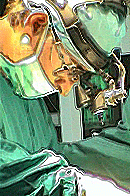EPENDYMOMAS
In common with their cell of origin, ependymomas are found
throughout the central nervous system, from frontal horns to
filum terminale. Intracranially, most occur in the fourth
ventricle of children, although supratentorial neoplasms
appear in both children
and adults. The spinal lesions, especially
those of the filum terminale, are usually seen in adults. A
rare neoplasm arises as a primary tumor in sacral soft
tissues or bone.
The intracranial lesions meet
little resistance to intraventricular expansion and can
become sizable exophytic masses before the onset of
obstructive symptoms. Such neoplasms are lobular,
well circumscribed, and often broadly attached to the ventricular
floor from which they arise. Secondary adhesions to other
ventricular surfaces may also form. Occasional
supratentorial lesions arise superficially, seemingly
remote from the ventricular system. Characteristically, in
the fourth ventricle, there is little invasion of the
ventricular wall, and but for their origin from the brain
stem, the neoplasms could be excised in toto. The larger
ependymomas in any site may be cystic. Calcification may be
present.
Intraoperatively, the fourth
ventricular ependymoma can resemble
a medulloblastoma pendent from the vermis, although it is
not usually as soft and necrotic as the medulloblastoma in
its typical form or as firm as the cerebellar neoplasm in
its desmoplastic variety. In the spinal cord, an
ependymoma's discreteness helps differentiate it from the
infiltrating astrocytoma. It can, however, be mimicked by
the similarly discrete but more vascular and much less
common spinal hemangioblastoma. Caudally, the filum
terminale can be confused with a nerve root and an ependymoma be mistaken for a schwannoma.
Microscopically, there are two classes of ependymoma: (1)
the classic lesion of the brain and spinal cord and (2) the
distinctive myxopapillary ependymoma of the filum terminale.
The classic ependymoma is a cellular neoplasm formed of
cells with small, dark nuclei. Cytoplasmic differentiation
produces two basic patterns. The first is the cells'
expression of their glial heritage in cell processes packed
with filaments.
When the ependymal cells are present in low density and
these processes are abundant, the lesion can resemble the
well-differentiated astrocytoma, and it may be difficult to
distinguish the two lesions in small specimens. One helpful
differential feature characteristic of ependymomas
in such fibrillar areas, as well as in more cellular regions,
is the orientation of cell processes to the wall of blood
vessels. This produces a perivascular eosinophilic anuclear
zone that, together with the perivascular nuclei, is known
as a perivascular pseudorosette.
The second distinctive feature
of the classic ependymoma is the epithelial differentiation
by which cuboidal cells form epithelial surfaces. These include small canals known as true
ependymal rosettes, large, flat epithelial surfaces, and
crude papillations.
In contrast to the choroid plexus papilloma, the epithelial
features are never exclusive, and cells with more glial
features are found within the interstices between rosettes
and canals. As is also true of astrocytomas of the
hypothalamus, optic nerve, and cerebellum, clusters of
cells resembling oligodendrocytes are occasionally seen. In
an uncommon ependymoma variant ("clear cell ependymoma"),
such lucent cells are especially prominent.
The structure of the
myxopapillary ependymoma is quite different
and may reflect the differences in embryology and anatomy
between the caudal nervous system, derived from the caudal
cell mass, and the principal portion of the nervous system,
derived by neurulation. In particular, the unique
juxtaposition of dense collagenous tissue and ependyma,
found exclusively in the filum terminale, may contribute to
the singular morphologic features of the myxopapillary
ependymoma. This lesion is extensively
vacuolated by microcysts, whose expansion forces the nuclei
into intervacuolar interstices. The mucosubstance also
swells the walls of the blood vessels to which the
neoplastic cells cling as the papillae that give this
distinctive lesion its name.
As in the other gliomas, there
is a spectrum of histologic anaplasia
in the classic ependymoma from the well-differentiated
lesion to the markedly cellular neoplasm. Anaplastic
lesions are not recognized in the myxopapillary group,
although the lesion is capable of wide dissemination though
CSF pathways in some instances.
The Kernohan group developed a grading system of four tiers
similar to that used for the astrocytomas, but this is not
widely used, because it has been difficult to establish
precise correlations between histologic grade and biological
behaviour due to the overriding importance of location and
extent of excision in the length
of postoperative survival. It
seems, however, that the more anaplastic
lesions behave more aggressively. The term
ependymoblastoma has sometimes been used for these more
anaplastic lesions, although others reserve this term for a
separate, extremely rare, neoplasm of childhood with
epithelial surfaces similar to that of the primitive neuroepithelium.
A neoplasm related to the
ependymoma is the subependymoma.
This discrete lobulated lesion occurs in either the
anterior lateral ventricle or the posterior fourth
ventricle.
In either, it is a
reasonably common incidental necropsy finding but a rare
surgical entity. Histologically, subependymomas are
remarkable for the clustering of uniform nuclei in a highly
fibrillar background. Some lesions in the lateral
ventricles can be totally excised, but attachment to the
medulla generally precludes this possibility in the fourth
ventricle.



